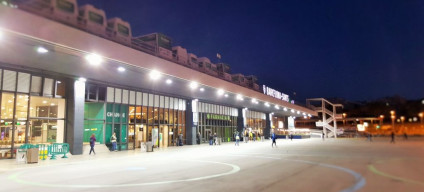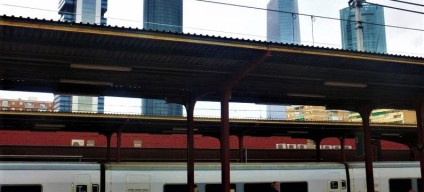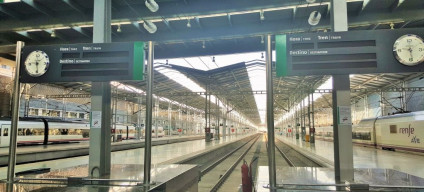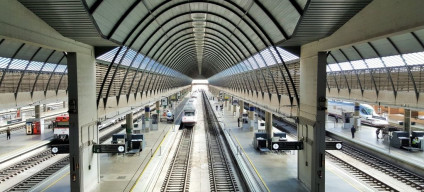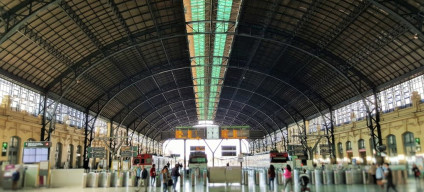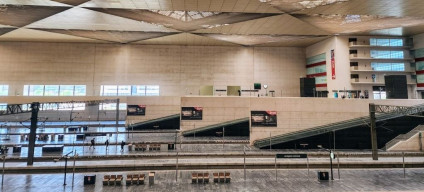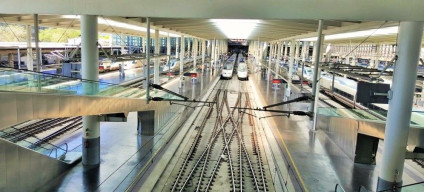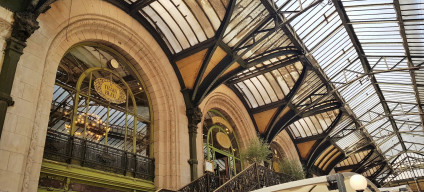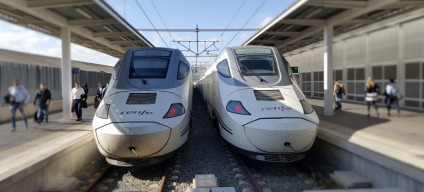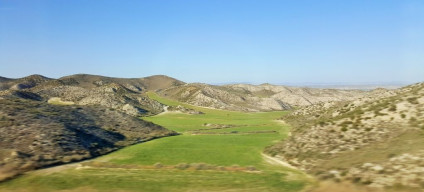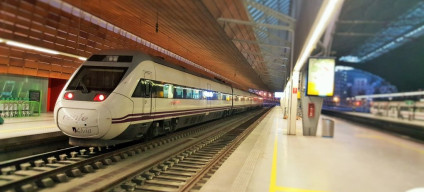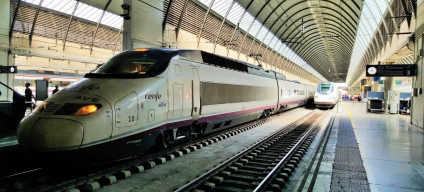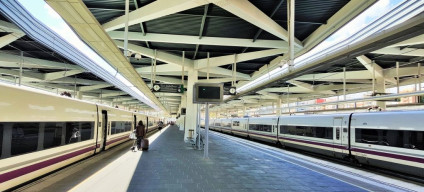Related Content
Content

Spain by train
This guide to travelling by train in Spain will tell you all you need to know about the major stations, how the ticketing works and how to travel on the fabulous trains.
Share
There’s a lot to love about travelling by train in Spain
The country has more high speed lines than any other in Europe, the trains that do and don't use them are rather fabulous and comparatively comfortable - and the scenery can be incredible.
But if you’re not Spanish, travelling in Spain by train can seem a tad bewildering, hence the weight of info below!
What's particularly worth knowing:
The 16 key things most worth knowing about taking the trains in Spain are:
(1) Renfe is the national company which operates most train services, but Adif is the name of the company that is responsible for the stations that the Renfe trains use.
So the presence of a station is often indicated by a sign saying 'Adif - white letters on a black background.
(2) Renfe's train services are placed into three broad categories;
- larga-distancia = the express trains
- media-distancia; Spain is a large country, so some media-distancia routes can be more than three hours long.
- urban local/commuter train services which are named differently depending on the city - ‘Cercanias’ is a more common name, but ‘Rodalies’ is used in Barcelona.
(3) The high speed lines radiate from Madrid and connect the capital with most other large cities including Alicante, Barcelona, Burgos, Girona, Granada, Leon, Malaga, Murcia, Ourense, Oviedo, Santiago de Compostela, Seville, Valencia and Zaragoza.
Trains can continue beyond the high speed lines to provide direct services between Madrid and the likes of Algeciras, Bilbao, Pamplona, San Sebastian and Vigo.
(4) Renfe places its larga-distancia trains into multiple categories - AVE, Alvia, Intercity, Avant and Euromed and Torre Oro - which are largely to do with whether they solely use the high speed lines, or partially use them before transferring to/from the conventional 'classic' routes.
(5) Because the high speed lines only radiate from Madrid, direct cross country services are less common:
- Euromed = Girona - Barcelona - Valencia - Alicante
- Torre Oro = Barcelona - Valancia - Albacete - Cordoba - Seville - Cadiz
Other trains operate on these routes:
- Barcelona - Zaragoza - multiple destinations in northern Spain
- Santander and Gijon - Madrid - Alicante and Valencia
- Barcelona - Zaragoza - Cordoba - Seville and Malaga
(6) Renfe doesn't have a monopoly on Spanish train services.
When travelling on the larga-distancia, high-speed routes between Madrid and destinations to the east and south including Alicante, Barcelona, Malaga, Murcia, Seville and Valencia, you can choose between travelling on three or four different high-speed train services:
- AVE = full service trains operated by Renfe
- iryo = full service trains very similar to the fastest trains operated in Italy by Trenitalia
- avlo = more basic, 2nd class only trains operated by Renfe
- Ouigo = more basic, 2nd class trains, similar to those which can be found on many high speed routes in France.
(7) All four services offer similar journey times.
The avlo and Ouigo services are typically cheaper because of the more limited on-board experience - plus they have more restrictive luggage allowances, which in turn require travellers to be at the stations earlier.
Though the full service iryo trains are also competitively priced, in order to attract passengers away from the Renfe operated AVE trains.
(8) Though for the time being Renfe has the monopoly on providing the high-speed express trains from both Barcelona and Madrid to destinations in northern Spain.
(9) The Renfe ticket booking service doesn't sell tickets for the iryo and Ouigo services, but the prices of all four services can be compared and booked on Trainline and Trenes.
(10) Advance discounted ticket prices are available on routes taken by the larga-distancia services, but not on most routes taken by the media-distancia services.
Though the periods of time ahead of travel, that tickets are released for sale, can vary according to the specific type of train service; for example, it can be up to 6 months ahead for AVE trains, but around 2 months ahead for Euromed services.
(11) Seat reservations are compulsory on all larga-distancia services and on most media-distancia services, including virtually all journeys on which the trains are specifically branded MD - the exceptions are the MD services on the Barcelona - Girona - Figueres - Port Bou route.
Reservations are automatically included when booking tickets online or at stations.
(12) There are no overnight train services, either in Spain or to/from Spain - but there are French overnight trains to the border locations of Cerbere and La Tour De Carol.
(13) Madrid has two main railway stations:
-
Atocha for destinations to the south and east including Barcelona, Cadiz, Girona, Granada, Malaga, Murcia, Seville and Zaragoza.
-
Chamartin for destinations to the north including Bilbao, Burgos, Leon, Ourense, Oviedo, San Sebastian, Santiago de Compostela and Vigo.
Though construction work is underway at Atocha, as the future plan is that many high speed services will travel direct between destinations in north and south Spain, travelling through Madrid and calling at both stations.
As a result most of the trains between Madrid and both Alicante and Valencia are currently using Chamartin station.
(14) When taking the high speed train services, from a major station you will usually encounter a procedure similar to checking-in for a flight.
Tickets will be checked before accessing a luggage screening area and then tickets will usually be checked again at the entrance to the via (platform/track) that your train will be departing from.
At the larger stations where trains commence journeys, such as Barcelona Sants and both Atocha and Chamartin in Madrid, you will be instructed to join a pre-departure queue, similar to the scenario at which passengers queue at an airport gate.
It inevitably takes time to process all the passengers, so aim to be at the station a minimum of 15 mins prior to departure (30 mins Barcelona Sants and both Atocha and Chamartin in Madrid) if you will be taking any of these train services; AVE, Alvia, Avant or Euromed.
The boarding procedures are even longer when taking avlo or Ouigo services, as the station staff will also need to check whether luggage requirements are being complied with.
(15) Unless you are taking a local/commuter train, avoid turning up at a station in the expectation of buying a ticket and swiftly boarding the next train to depart.
On many Spanish train routes, gaps of more than three hours between departures are the norm.
(16) The cities along the Atlantic Coast of northern Spain are linked by a system of narrow gauge lines, similar to those used by Swiss mountain railways, most of which are part of the Cercanías AM network.
Services between cities can be comparatively infrequent, but Euskotren, which is not managed by Renfe, operates a network of lines in north-east Spain, around Bilbao and San Sebastian/Donastia.
Trains on its routes, which include those which link San Sebastian with both Bilbao and the French border at Hendaia / Hendaye, tend to operate every 30 to 60 mins.
Links to Useful Info


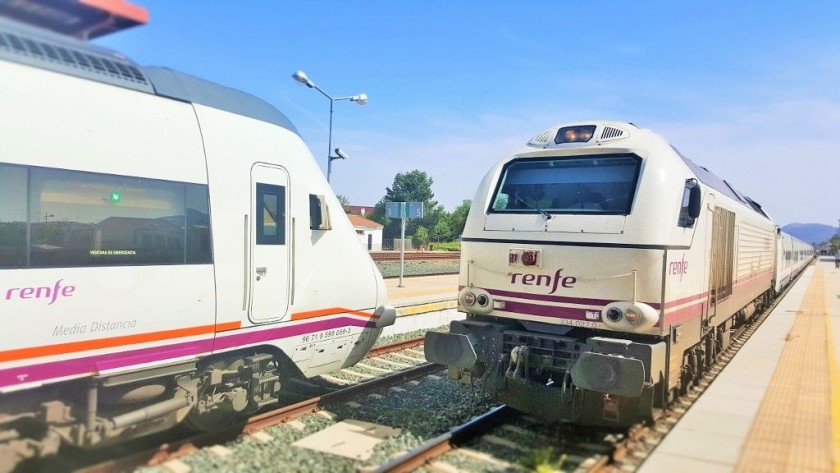
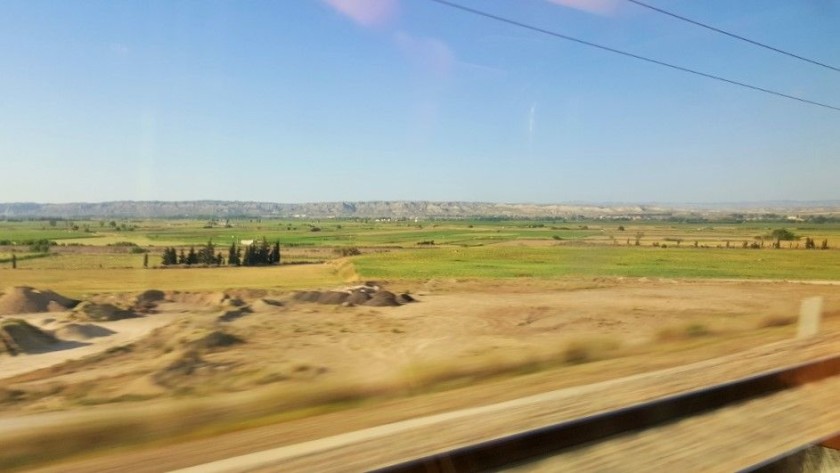
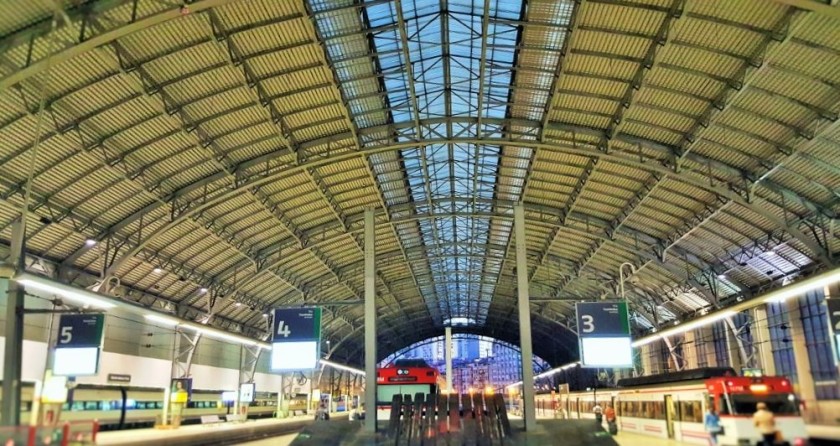
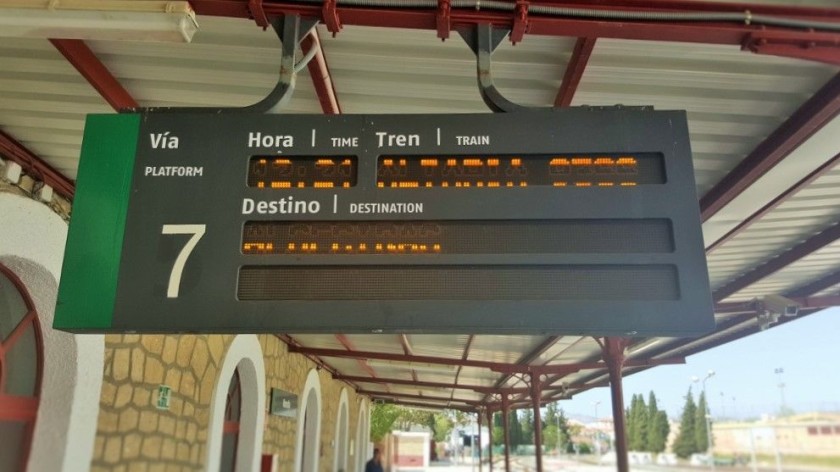

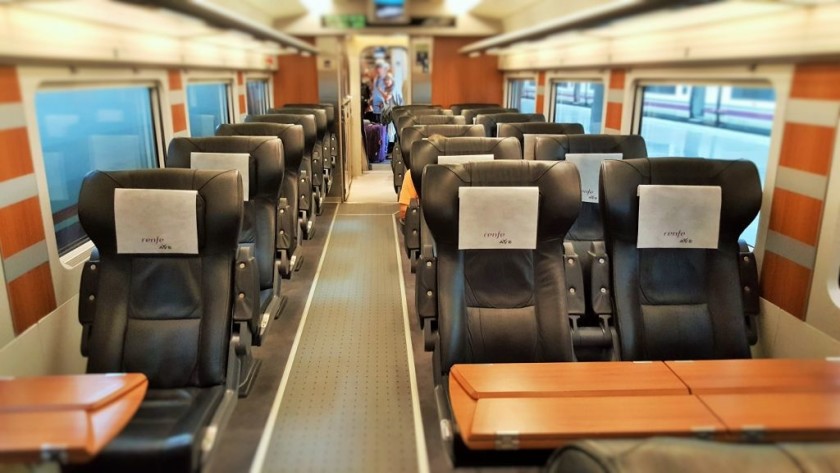
Travelling on the Spanish trains:
Six things which are good to know about the trains in Spain:
- The trains are placed into three board categories:
- the local/commuter trains in the cities
- the media-distancia services
- the larga-distancia services; the long-distance express trains.
- The larga-distancia services are the Alvia, the avlo, the [AVE](Barcelona Sants and both Atocha and Chamartin in Madrid), the Euromed, the Intercity, the iryo, the Ouigo and the Torre Oro services.
- The Media-Distancia services are the Avant services, the MD services and the Regional Express services.
- So when travelling on many routes there is a choice between different train services.
- Also the type of train services can impact on travelling with bicycles and dogs.
- Not all trains in Spain are provided by the national rail operator Renfe, the exceptions include the iryo and Ouigo services, some of the local services in Barcelona and Valencia and the local services in north-east Spain
More info on all of these things and more are in the full guide which you will find below.
Detailed train guides
Click on the buttons below to access info such as on board facilities, and what to look out for when boarding and travelling with luggage/bikes.
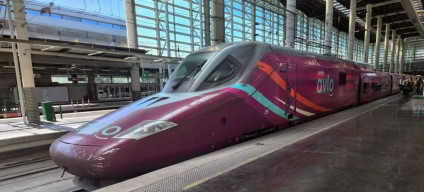
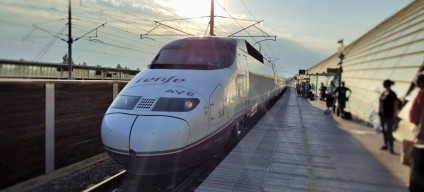


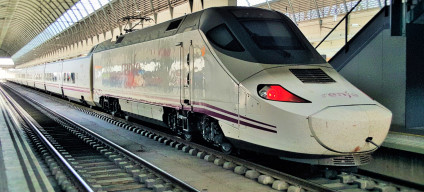
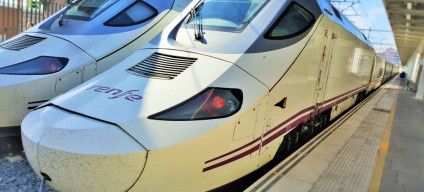

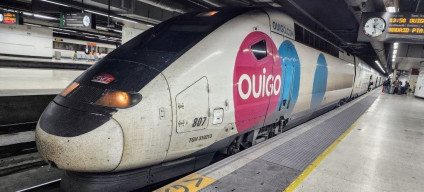
Notes on the major stations in Spain:
Larger stations in Spain don’t have names which equate to ‘Central’ etc, they either have;
- only the main city name
- are named after the part of the city in which they’re located
- are named in honour of an individual.
The larger stations in Spain also tend to have unique characteristics compared to those in other European countries and in summary they are:
(1) Take-away food/drink counters aren’t particularly common, instead canteens/cafés where you sit and have your food/drink are the norm.
So if you want to buy something simple like a bottle of water or a snack, you might have to go into the canteens and purchase it; you won’t have to drink/eat your purchases at the table.
Other shops/news-stands etc in the stations don’t tend to sell drinks and snacks.
(2 Larger Spanish stations don’t tend to house many stores/shops, though Madrid Atocha and Malaga Maria Zambrano station are notable exceptions; so don’t count on being able to stock up on travel essentials at the station.
Finding Your Train & Boarding:
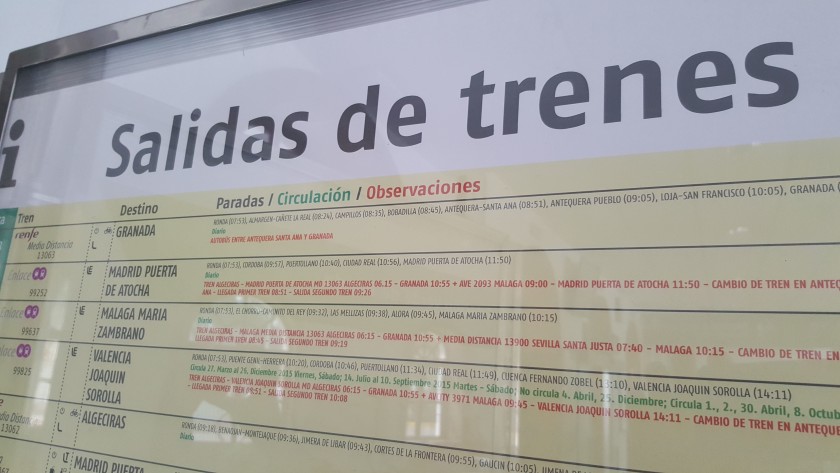
Something to watch out for is that on the main departure screens at stations the ‘departure/salidas’ information is as large as the info for arrivals, so take care not to confuse the two.
The ‘salidas’ info will be on the right and the arrivals will be on the left.
In the station there are also separate, similar looking, info posters listing the details of the arrivals OR the salidas/departures, so take not to mix them up.
The via (platform/track) that a larga-distancia train will be departing from is normally confirmed 15 –30 mins before departure; 30 mins is the norm at Barcelona Sants and the main stations in Madrid.
At some stations the departure time on the screens will begin to flash to indicate that boarding has commenced.
Keep an eye on the departure/salidas info screens, as the confirmation of the via (track/platform) that your train will be leaving from, isn’t usually announced.
The system used for assigning numbers to the vias/tracks/platforms at larger Spanish stations can seemingly lack logic, so it’s best not to wonder why and just follow the signs.
The Coche (coach/carriage) and Plaza (seat numbers) will be on your ticket - check the plaza number before you step on to the train.
Boarding an AVE service:
At the main stations the boarding procedure for boarding AVE, Alvia and Euromed train services is similar to checking-in for a flight.
Tickets will be checked before accessing a luggage screening area and then tickets will usually be checked again at the entrance to the via (platform/track) that you’re train will be departing from.
So keep your ticket where you can access it easily, you will need to show it prior to boarding.
At Barcelona Sants and both Madrid Atocha / Chamartin, a departure lounge is on the other side of the luggage screening are.
Regardless of the station, when the via (track/platform) appears on the departure screens, queues will form at the gate which gives acesss to each via.
The gates are typically opened around 5 mins before departure, but at Barcelona Sants and both Madrid Atocha / Chamartin, the via can be confirmed up to 30mins pre-departure, so you can be in the queue for 25 mins; or longer if departure is delayed!
Note that priority boarding is not available to holders of Confort or Premium Class tickets.
Access to the trains beyond the gates will close around two mins before departure, to ensure that all passengers can be processed.
In effect what this will mean is that around two mins before departure, the train departure details will be removed from the departure info screens.
So would be travellers arriving last minute at the stations, won’t know which via/platform/track, the train will be leaving from.
Because you have to pass through ticket-checks before boarding larga-distancia departures, Spain is a country where you don’t have to be overly concerned about boarding the wrong train in error.
Though to give further reassurance, there are usually electronic displays on the train doors, showing the coach number, the final destinations and the calling points of the departure.
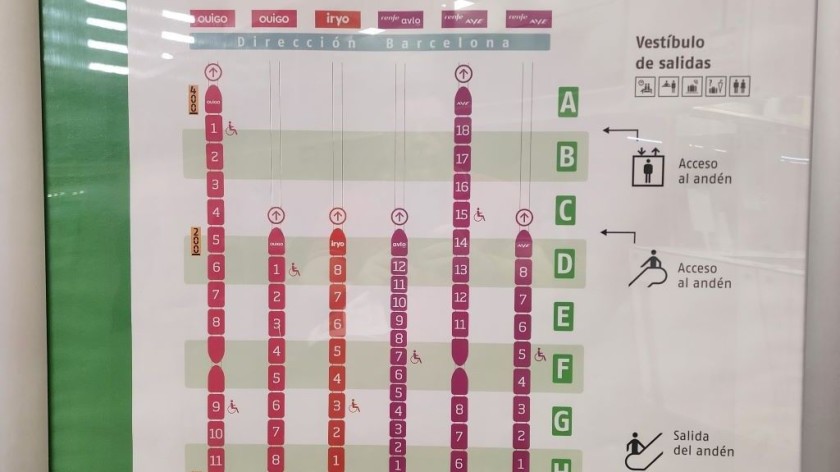
At intermediate stations
When boarding a train at a station where it commences its journey, you find the coche/coach in which your seat(s) is located by looking at the coche/coach numbers by the train doors.
You walk along the via (platform/track) until you find the right number.
However, at intermediate stations such as Cordoba and Zaragoza-Delicias, the vias (platforms/tracks) are split into zones, A, B, C etc, but the electronic departure indicators don't give an indication of where to wait board into each specific coche/coach.
Despite that this info is good to know, as the trains will have at least eight coaches and will be scheduled to spend around only 2 mins at each station call.
So in the pre-departure waiting areas at these stations, you should be able to find train zone posters, an example of which is shown above - they seem to have a design specific to each station.
The posters will give an idea of which zone the specific coaches of each type of train will occupy, when they arrive in the station.
Though you can also ask the staff - and asking the staff where you should wait for easy boarding, is the only option at smaller, less busy stations.
The lounges:
The Club lounges at major stations in Spain can be accessed by Comfort/1st class ticket holders who have booked 'Prémium' tickets.
They cannot be accessed by holders of 1st class rail passes.
Left luggage:
The left luggage lockers can only be accessed once you have passed through security checks at the entrances/exits to the left luggage areas of a station, when depositing AND collecting your bags.
As the left luggage offices are staffed, pay attention to the opening hours when dropping off your bags.
Also when you’re picking up your bags don’t go straight to your locker – you will have to hand any other bags you happen to have with you at the time, to the attendant for screening.
Detailed info on the major stations
Click the buttons below to discover how to travel to and from the stations by public transport, plus links to additional info including the station and city websites.
Notes on the ticketing:
The Spanish national operator Renfe has recently simplified the types of ticket available and how they can be used which is welcome news.
It can be worth persevering with booking a ticket for a long-distance journey on the Renfe website for these two reasons:
- You can save money by booking in advance;
- Trains can sell out completely days in advance.
Despite the investment in high speed lines, Renfe's long distance trains tend to operate less frequently than high speed trains in other European countries
Hence some larga-distancia routes can have only 2 or 3 x trains per day.
It’s worth checking, because when that is the case, it’s not unusual for seats to sell out days in advance in both Comfort (1st) Class and Estander (2nd) Class on the most popular departures.
Particularly if you will be travelling to or from Barcelona and Madrid on the routes with the infrequent trains.
Though something to look out for is that the Renfe booking service doesn't sell tickets for the iryo services and the Ouigo services, which now offer alternatives to travelling on Renfe's trains on many of the high-speed routes.
These two services and Renfe's trains can be compared by using Trainline and Trenes.
Saving money on Renfe's long-distance trains
The Spanish rail operator does not sell specific types of discounted tickets, instead limited numbers of tickets at cheaper prices are typically made available on all types of ticket on each departure for the routes taken by AVE, Alvia, Euromed, IC trains and the Torre Oro train.
The Basico tickets are cheaper because they have more stringent terns and conditions around exchanges and refunds; and if you book these tickets your seat(s) will be in the equivalent of second class; more information is available on our Spanish train tickets guide
However, in general, obtaining tickets for the cheapest possible price is less clear cut than is typical in other European countries.
How popular/busy a train is likely to be, tends to have a bigger impact on prices, in comparison to how far in advance you are booking.
On the routes between Madrid and Barcelona and Malaga and Seville a few of the departures can be significantly cheaper, no matter how far ahead you book.
Though with tickets typically available on the these routes 6 months ahead of the travel date, the very cheapest tickets prices can have 'sold out' within a few months of the tickets being placed on sale.
On the Alvia routes between Madrid and northern Spain, tickets are typically placed on sale two months ahead and the further ahead you book, the cheaper the tickets will be.
Tickets aren’t discounted for the shorter distance Avant and Media-Distancia (MD) services and on most RE (Regional Express) services.
Though avoid booking tickets for the Avant services last minute at the station; in particular some Avant trains between Madrid and Toledo can sell out days in advance.
Booking 1st class tickets online:
The online booking service of the Spanish national rail operator, Renfe, doesn't sell 1st class tickets, instead the type of tickets available are categorised by the their terms and conditions and the benefits they provide to travellers.
Prémium ticket benefits include a complimentary service of at seat refreshments including a hot meal; and as these meals are only served in Confort/1st class in AVE and Euromed trains on Mondays to Fridays and Sundays; so if you book a Prémium ticket your seats will be in Comfort/1st class on these trains.
When booking tickets for journeys by the Alvia, AVE, Euromed and Torre Oro trains, along with most journeys by IC trains, Elige tickets will be available and an upgrade to Comfort/1st class will be an option.
Click on the Estander/2nd class price and you will see the 'Elige + Comfort' button which provides the access to the upgrade.
Booking at the station:
If you will be booking tickets/reservations at the station, allow extra time as not all ticket counter staff will speak English, so you may have to wait a little longer for a clerk who can, to become available.
At some large stations including Barcelona Sants and at both Atocha and Charmatin in Madrid, counters selling tickets for travel that day are divided into larga-distancia ticket desks and media-distancia ticket desks.
So take care not to mix up the two, you want to avoid waiting in line for no reason.
Other stations have general ticket offices/desks that sell tickets for any train leaving that day.
Large stations will also have separate ticket desks/offices which only sell advance tickets for larga-distancia journeys.
These advance ticket offices often use AVE branding on the doors and windows, but;
- they will sell advance tickets for other larga-distancia services and not just the AVE trains/services
- they don’t sell tickets for AVE trains departing that day.
Renfe’s ticket machines aren’t, in our humble opinion, particularly easy to use, you have to scroll through the alphabet when searching for stations – and they seemed to only sell tickets for journeys by direct train when we used them.
Also worth knowing:
Unless you will be traveling on the commuter/local train networks in and around the big cities, if you want to book tickets last minute at the station, always check the departure times before heading to a station.
Gaps of more than 3 hours between departures are not uncommon, particularly if you WON’T be travelling to or from Barcelona and Madrid.
Child tickets:
Renfe is the operator of the national rail services in Spain and it has a blissfully simple child tickets policy, namely children aged 5 -13 and under are entitled to a 40% discount on any of its rail tickets.
If you want to place a child aged four and under in its own seat, they will also have a 40% discount on the ticket price, but if you'll be happy to travel with the child on their lap, then there is no charge.
Tickets for dogs:
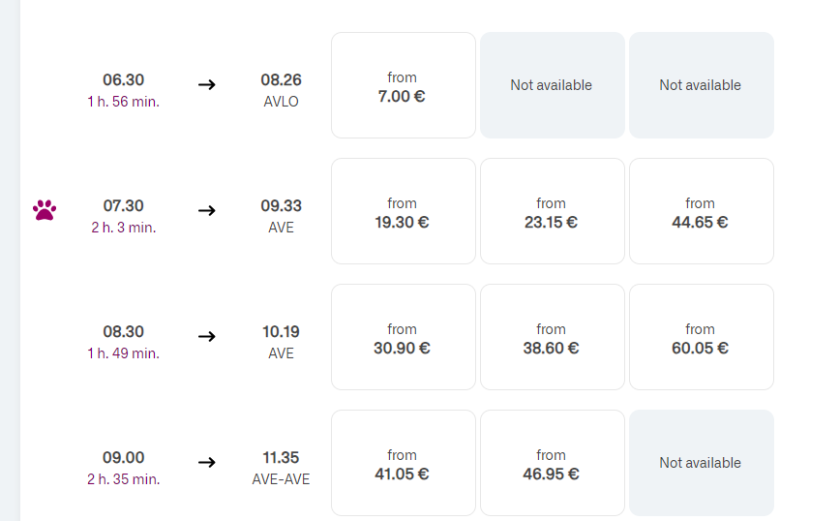
On the standard long distance express trains, the AVE, Alvia, Euromed and IC services, you can add a dog as an extra when making booking:
The flat rate prices, irrespective of distance and departure are:
Basic (second class) = €20
Comfort XL or Elige + Comfort tickets (first class) = €10
Premium Class = no charge
However, dogs can only be taken on board most of these larga-distancia services if they can travel in a container measuring no more than 60x35x35 cm and do not weigh more than 10kg.
If your dog weighs between 11kg and 40kg it can be taken on a few departures by AVE trains on routes between Madrid and Alicante, Barcelona, Valencia and Zaragoza.
These departures now have a dog paw symbol, when looking up a journey on the Renfe website.
Though you will need to select the more expensive 'Elige' tickets and the reservation fee for the dog is €35.
Note that:
- you can take smaller dogs which weigh up to 10kg on departures with no paw symbol,
- you can't take dogs which weigh between 11kg and 40kg on any Alvia, Euromed or IC service,
- the English translation implies that you will be reserving a seat for the dog, but you will be reserving a place on a special mat that will be placed on the floor in front of the seat,
- you cannot use the seat selection service that's typically available when booking 'Elige' tickets.
On the other trains operated by Renfe, including the Avant, MD and Regional-Express services, the dog can weigh more than 10kg and it doesn't have to be placed in a container.
For travel on these services it looks as though the dog ticket price will be 25% of the Adult rate.
The guide to using tickets and rail passes:
Journeys from Barcelona
The journey guides include access to booking links and information about the trains, tickets and destination stations. Plus for the scenic routes there are insights on how to make the most of the rides on the trains.
Journeys from Madrid
The journey guides include access to booking links and information about the trains, tickets and destination stations. Plus for the scenic routes there are insights on how to make the most of the rides on the trains.
Most scenic routes:
Barcelona > Puigcerda > La Tour De Carol
Bilbao <> Santander
Bilbao <> San Sebastian/Donastia
Bilbao <> Miranda de Ebro
Malaga > Ronda > Algeciras
Malaga <> Cordoba
Ferrol <. Gijon
Granada <> Almeria
Leon <> Monforte de Lemos
Leon <> Oviedo
Oviedo <> Santander
Zaragoza <> Canfranc
Zaragoza <> Valencia
Short videos showcasing some of these journeys have been uploaded to the ShowMeTheJourney channel on YouTube.
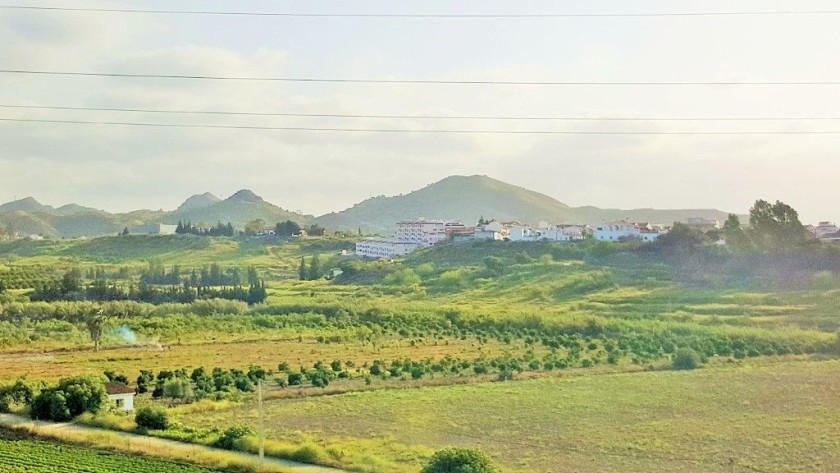
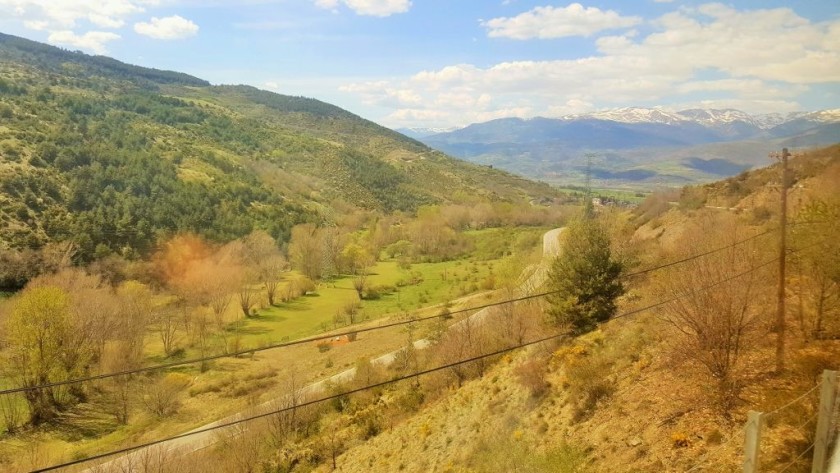
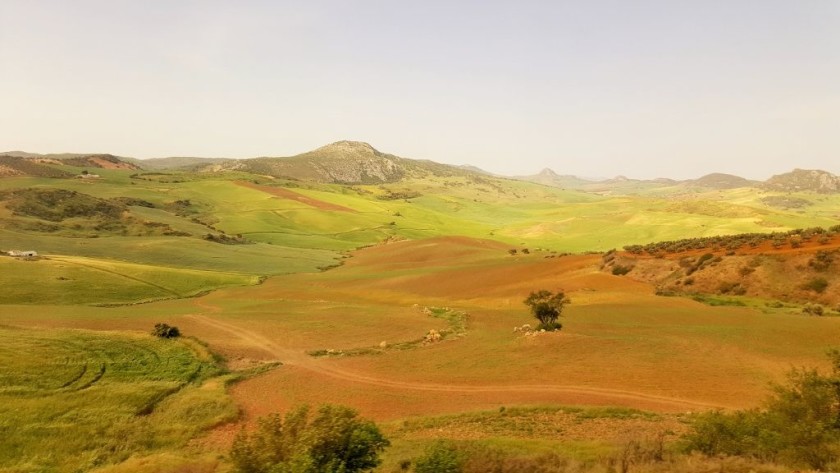
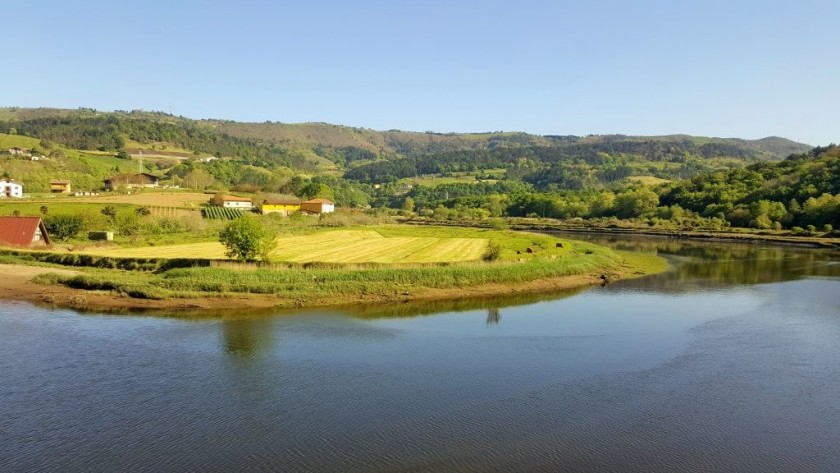
International rail journeys
Please support ShowMeTheJourney
This second version of ShowMeTheJourney is exciting and new, so we are genuinely thrilled that you are here and reading this, but we also need your help.
We’re striving not to let anything get in the way of providing the most useful service possible, hence a facility has been set up with DonorBox which can be used to support the running costs and make improvements.
Instead of advertising or paywalls, your financial support will make a positive difference to delivering an enhanced service, as there’s a lot of ideas which we want to make happen.
So if you have found the info provided here to be useful, please go here to say thank you.
Relevant train travel guides:
Pan-European Train Travel Guides
This second version of ShowMeTheJourney is exciting and new, so we are genuinely thrilled that you are here and reading this, but we also need your help.
We’re striving not to let anything get in the way of providing the most useful service possible, hence a facility has been set up with DonorBox which can be used to support the running costs and make improvements.
Instead of advertising or paywalls, your financial support will make a positive difference to delivering an enhanced service, as there’s a lot of ideas which we want to make happen.
So if you have found the info provided here to be useful, please consider saying thank you.
See if there’s a unique journey guide for your trip, featuring info on the trains, tickets & stations.

This is one of more than 100 train travel guides available on ShowMeTheJourney, which will make it easier to take the train journeys you want or need to make. As always, all images were captured on trips taken by ShowMeTheJourney.



